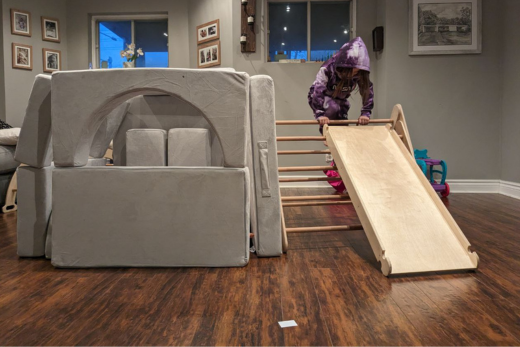What is a Play Couch?
A play couch is a versatile toy & sometimes piece of furniture designed to foster imaginative play and creativity in children. Typically made of foam, these couches come in various shapes, sizes, and configurations, serving as a platform for exploration, climbing, and building. They provide a canvas for imaginative scenarios, from transforming into forts or castles to facilitating physical activities like climbing and jumping.
Benefits of Play Couches
- Gross Motor Skills Development: Engaging with play couches aids in refining gross motor skills as children climb, crawl, and explore different physical movements.
- Cooperation and Independence: Encourages cooperative play among children while also promoting independent and imaginative play sessions.
- Sensory Stimulation: The textures and features of play couches offer sensory experiences, aiding in sensory development and exploration.
- Get active: Lots of climbing, building and jumping to keep kids off the couch and moving their bodies.
- Stay off the screens: A fun way for kids to play without the ipad.
- Imaginative Play: Engage in pretend play scenarios to practice real-life situations such as going to the store or the doctor.
- Combine with other toys: Use a play couch to play restaurant and incorporate pretend food. Make a tunnel to race cars. Create a soccer net to play sports.
Features Seen On Play Couches
- Zipper Pockets: Hide zippers in pockets to prevent walls & floors from scratching.
- Waterproof Liners: Protecting the foam from spills or accidents and prevent mold growth on wet foam. Keeps foam safe during washing from kids and pets touching it.
- Velcro or Magnets: Facilitating attachment of detachable pieces, although caution is advised with magnets due to safety risks, especially with young children.
- Wipeable, Washable or Water-Repellent Fabric: Ensuring easy maintenance and cleaning.
Understanding Foam
Density
Foam density refers to the measure of mass per unit volume of foam material and serves as a crucial indicator of its firmness and supportiveness. The density of foam is typically measured in pounds per cubic foot (lbs/ft³) or kilograms per cubic meter (kg/m³). Higher density foam means there is more material compacted into the same volume, resulting in a firmer and more supportive structure. For instance, a foam with higher density will offer better support for weight-bearing activities or for older children engaging in play. On the contrary, lower density foam tends to be softer and more pliable, making it comfortable for younger kids or for activities where a softer surface is preferred. Understanding foam density is essential when choosing play couches or foam-based products, as it directly correlates with the firmness and overall feel of the furniture or accessory being considered. A higher density foam will therefore last longer and stand the test of time. There is additional weight involved and too dense of a foam will be heavy for younger kids to move the pieces independently. High density foam may also not be able to get compressed for shipping or can only be compressed for a very short time without compromising quality.
ILD (Indentation Load Deflection)
ILD, or Indentation Load Deflection, is a metric used to measure the firmness or hardness of foam. It represents the amount of force, in pounds, required to indent a foam sample by 25% of its original thickness. A higher ILD indicates firmer foam, as it requires more force to compress it. For instance, foam with an ILD of 30 would feel softer compared to foam with an ILD of 50. ILD is crucial in determining the suitability of foam for specific purposes; higher ILD foam provides more support and is often preferred for weight-bearing activities or applications where durability and resilience are required, while lower ILD foam is softer and more yielding, offering comfort and cushioning for activities that prioritize a plush feel. Understanding ILD assists in selecting the appropriate foam type for different age groups or activities when considering play couches or other foam-based products. If your goal is to build weight-supporting structures you will want high ILD foam. If you intend to use the play couch as a couch or bed, then you will want to look at lower/medium ILD foam so that it will be comfortable and not feel physically hard to touch. Younger children will also benefit from medium ILD foam as the high ILD foam can hurt a child if it lands on them.
CertiPUR-US® Certification
CertiPUR-US® is an independent, non-profit organization dedicated to ensuring the safety, quality, and environmental friendliness of foam used in various products, including mattresses, furniture, and upholstered goods like play couches. To achieve CertiPUR-US certification, foam manufacturers must adhere to stringent criteria and rigorous testing processes. Certified foams must be free from harmful chemicals such as formaldehyde, ozone depleters, PBDEs, TDCPP or TCEP flame retardants, mercury, lead, and other heavy metals. They also must have low volatile organic compound (VOC) emissions to promote indoor air quality. For play couch foam, CertiPUR-US® certification provides assurance to consumers that the foam used in these products meets strict safety and environmental standards. It signifies that the foam has been independently tested and certified to be free from certain harmful substances, contributing to a healthier and safer environment for children during playtime.
Fabric Choices for Play Couches
Play couches come in various fabric options, each offering distinct characteristics and benefits tailored to different preferences and needs. Microsuede stands out as the most prevalent choice due to its durability, ease of cleaning, and soft texture, making it a popular fabric across numerous brands. However, for households with pets, double brushed fabrics present a favorable option, as they are more resistant to pet hair and scratches. Additionally, some play couches feature fabrics designed for outdoor use, such as taslan and vegan leather, known for their wipeable surfaces ideal for mess-prone environments. Nevertheless, caution is advised with taslan and vegan leather, as they can be prone to scratching, particularly in homes with pets. Understanding the characteristics and maintenance needs of each fabric type helps in selecting the most suitable option based on specific household requirements and preferences.
Care and Maintenance
Washing and drying your play couch cover can help maintain its cleanliness and longevity. Before laundering, always refer to the manufacturer's care instructions specific to your cover's fabric type. Many covers are machine washable, but it's essential to use a gentle cycle with cold water to prevent shrinkage or damage. For spot-cleaning or minor stains, a damp cloth or gentle detergent can be used. Avoid using bleach or harsh chemicals that might compromise the fabric's integrity. Once washed, air-drying is typically recommended to prevent potential shrinkage or damage from high heat. Some covers might be dryer-safe, but it's advisable to use a low or no-heat setting to preserve the fabric quality. Proper care and maintenance through washing and drying ensure a clean and hygienic surface for continued safe and enjoyable playtime on your play couch.
Pets and Play Couches
Introducing play couches into a household with pets requires consideration for both the comfort of the pets and the maintenance of the couch. While pets might find the play couch a cozy spot to lounge or play, it's essential to select a fabric that is durable and pet-friendly. Fabrics that are scratch-resistant, easy to clean, and less prone to trapping pet hair or odors can be beneficial. Regularly vacuuming or using lint rollers can help manage pet hair on the couch cover. Additionally, training pets to avoid scratching or biting the play couch can help maintain its condition. Waterproof liners will also be important for families with pets to maintain the cleanliness of the foam as well as ensure no naked foam is exposed when covers are being washed.
Add-On Shapes
Many play couch brands now offer add-on shapes if the play couch did not come with enough pieces to build with the standard play couch. A wide semi-circle commonly called a Rocker is used for kids to rock back & forth on. A tall arched doorway creates an entry to forts. However, not all arches are wide enough to stand alone and often must be used in combination with other pieces from the play couch. With the Barumba Play, you can place the arch on top of the arm rests to create the same arched doorway with the pieces that come with the play couch. Another shape commonly offered is a wedge to use as a slide. You can also use the base piece as a slide on the stairs or with a triangle or other shapes underneath to create a slide without the need for a wedge.
Unboxing and Puffing Up
Unboxing a play couch is an exciting moment that marks the beginning of its journey from compressed packaging to a full, usable piece of furniture. Notably, overseas brands often require weeks to fully expand and fluff up due to their extended time in compressed packaging during shipping. In contrast, play couches manufactured in North America typically fluff up almost immediately upon unboxing. This quick expansion is attributed to the shorter duration these North American-made couches spend compressed in their boxes during transportation. The reduced time in compression allows them to swiftly regain their intended shape and firmness, ensuring a quicker readiness for playtime and immediate enjoyment after unboxing.
Additional Accessories
Combining a play couch with other toys in the home can make it that you find new ways to have fun with old toys. Play Panels turn your play couch into scenes such as a coffee shop or fire station. Sarah’s Silks make beautiful roofs for forts or airy doorways. A Wooble board makes a perfect slide or ramp in or out of a play couch house.
Safety Testing
There are a variety of toy safety testing standards that can be conducted by third party laboratories to ensure that a play couch is safe. Fabric should be tested for flammability, lead, heavy metals, PFAS, etc to ensure it is safe for your family. No all play couch brands conduct safety testing or are PFAS free. Enquire with the brand or check out their FAQ or website product page to see if they have gone through testing for their play couch.


